I have been, or can be if you click on a link and make a purchase, compensated via a cash payment, gift, or something else of value for writing this post. As an Amazon Associate, I earn from qualifying purchases. Please read my full Affiliate Disclosure for more information.
Ever wondered how to transform your kitchen into a sanctuary of calm and coziness? Japandi interior design seamlessly blends the minimalist elegance of Japanese aesthetics with the warm, inviting feel of Scandinavian style, making it an incredibly popular choice for those seeking a peaceful yet functional space. Its focus on simplicity, natural materials, and subtle textures creates kitchens that are not only beautiful but also promote relaxation and mindfulness.
In this article, you’ll find a treasure trove of inspiring ideas and practical tips to bring Japandi charm into your own home. From sleek open shelving to cozy textiles and thoughtful layouts, each concept is designed to help you craft a kitchen that exudes tranquility and effortless style.
Whether you’re starting from scratch or updating your current space, get ready to discover a variety of ideas to create a calm, cozy, and beautifully balanced kitchen environment. Creating open shelving in your kitchen is a fantastic way to combine practicality with the serene aesthetic of Japandi design.
This approach emphasizes simplicity and accessibility, allowing you to display cherished ceramics, simple glass jars, or wooden utensils that add character without clutter. The open shelves should be sleek and unadorned, often made from light or medium-toned wood, with clean lines that blend seamlessly into the overall calm environment.
Imagine a set of floating shelves in a soft matte finish, mounted against a neutral wall—perhaps in a warm beige or taupe. They’re styled with a handful of understated ceramics in earthy tones, small potted herbs, and minimalist wooden or bamboo accessories.
The space feels airy and organized, with each item carefully curated to enhance the sense of calm. The textures of the ceramics and wood contrast gently, offering tactile interest without overwhelming the senses.
This setup invites a relaxed, clutter-free atmosphere where everything is within reach and visually soothing. To implement this look, start by choosing durable, lightweight wood or MDF boards with a smooth, flat surface.
Securely mount the shelves at varying heights or in a symmetrical pattern, depending on your preference. Keep accessories minimal—think simple white or matte black bowls, small woven baskets, or glass canisters.
Use concealed brackets or floating shelf hardware for a seamless appearance. For a budget-friendly option, repurpose reclaimed wood or install adjustable shelving brackets for flexibility. The key is to keep the display intentional and uncluttered, creating a balanced and functional focal point.
2. Neutral Color Palette with Warm Earth Tones
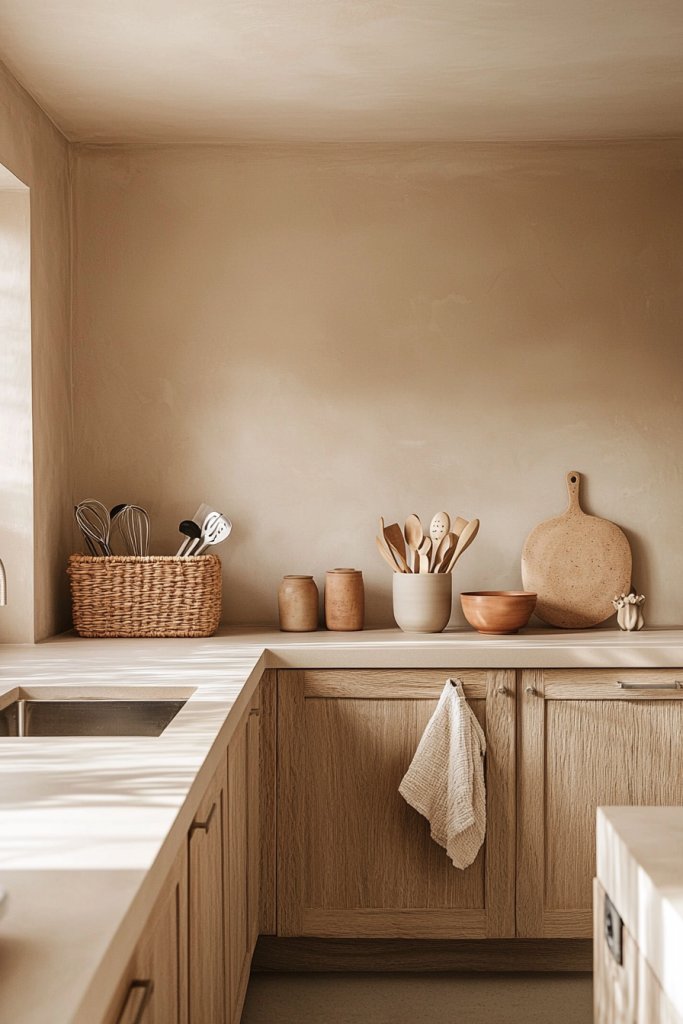
A soothing, neutral color palette is at the heart of Japandi kitchen design, fostering a calm and inviting atmosphere. Soft beiges, warm taupes, gentle greys, and muted browns serve as the foundational tones, creating visual harmony and a sense of peaceful simplicity.
Recommended Products to replicate this idea
| # | Preview | Product | |
|---|---|---|---|
| 1 |

|
Stone Care International Daily Cleaner/Polish & Sealer Stone Care Kit for Granite, Quartz,... | Check Latest Price |
| # | Preview | Product | |
|---|---|---|---|
| 1 |

|
LANE LINEN Kitchen Towel Set- 12 Pack 14"x25" Dishtowels for Kitchen, Absorbent 100% Cotton Dish... | Check Latest Price |
These shades work beautifully together to evoke warmth and serenity, making your kitchen feel like a retreat from the hustle and bustle. Visualize a kitchen bathed in natural light, with walls painted in a soft, warm beige that complements the natural wood cabinetry.
Countertops in a subtle, matte stone with gentle veining add a touch of understated elegance. Accents—such as a ceramic utensil holder or a woven basket—are in earthy tones like terracotta or warm clay, enhancing the organic feel.
The overall look is cohesive, with colors blending seamlessly to create a welcoming, balanced environment. Textures like matte ceramics and soft fabrics further amplify the calm, tactile experience of the space.
To achieve this palette, select paint colors in warm neutrals and opt for cabinetry and countertops in materials like light oak or limestone. Incorporate textiles such as linen dish towels or wool rugs in similar hues to add cozy layers.
When choosing accessories and decorative objects, stick to natural materials and muted colors to maintain harmony. Keep the overall design uncluttered, allowing the subtle variations in tone and texture to create visual interest without overwhelming the senses. This color scheme ensures your kitchen remains a serene sanctuary.
3. Natural Wood Cabinetry with Smooth, Flat-Panel Doors
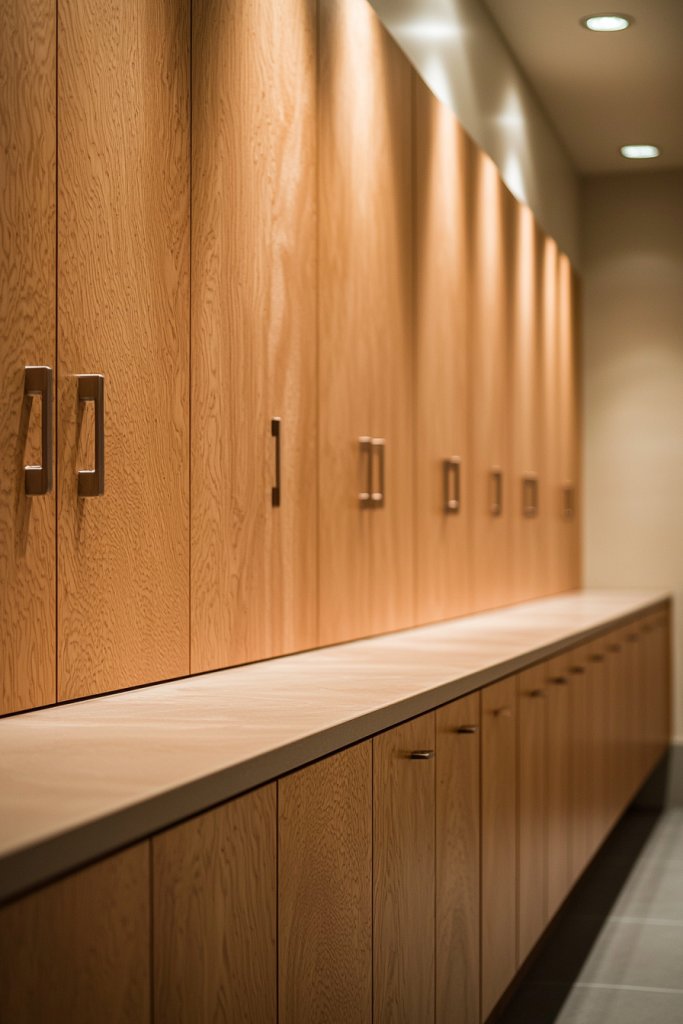
Natural wood cabinetry is a cornerstone of Japandi style, bringing warmth and simplicity into the kitchen space. Flat-panel doors with minimal hardware embody the clean, streamlined aesthetic that defines this design approach.
Light or medium-toned woods like oak, ash, or maple work best, emphasizing the natural grain and texture that add visual depth without complicating the overall look. Picture a row of cabinets in a soft matte finish, with flat, handleless doors that extend seamlessly from wall to wall.
The wood’s subtle grain pattern creates a gentle movement, adding an organic element that’s both calming and refined. This setup pairs beautifully with neutral walls and understated countertops, allowing the natural beauty of the wood to stand out.
The smooth doors invite tactile pleasure—soft to the touch and visually soothing—while maintaining a clutter-free appearance that promotes tranquility. To implement, choose cabinets in a light or medium wood finish, ensuring they’re crafted with high-quality materials for durability.
Opt for flat-panel doors with integrated push-to-open hardware or minimalist handles for a sleek look. Pair with simple, unobtrusive hardware or go handleless to keep the lines clean.
For a more budget-conscious approach, consider peel-and-stick wood veneer or laminate options that mimic real wood. The goal is to create a warm, inviting atmosphere with a focus on craftsmanship and understated elegance.
4. Soft, Textured Linen or Cotton Kitchen Towels
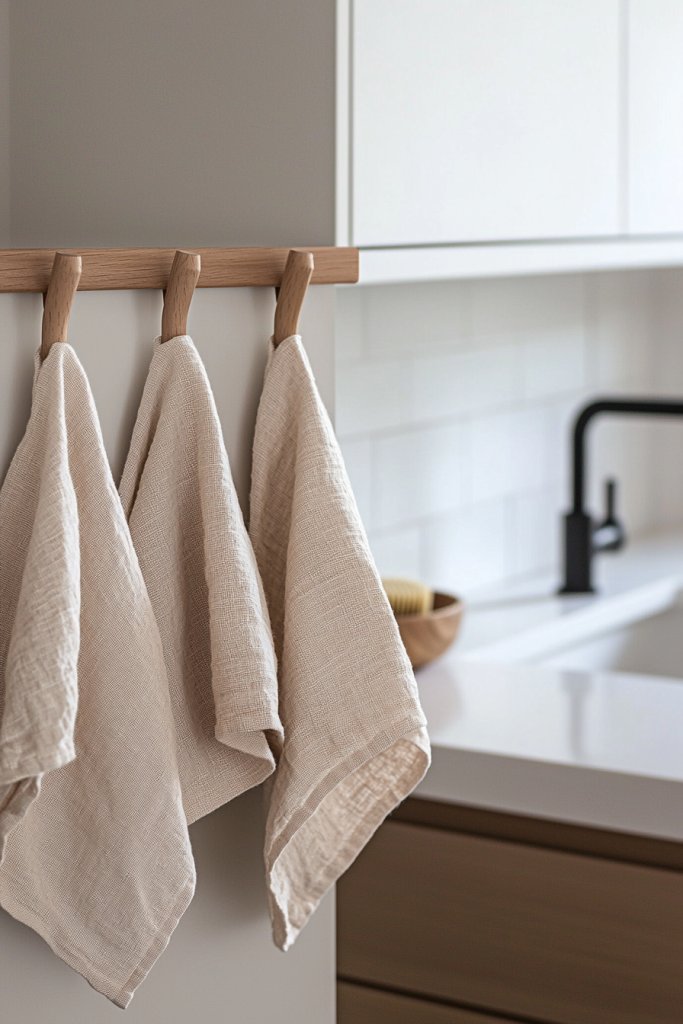
In a Japandi kitchen, textiles are more than just functional—they add a layer of tactile softness and visual warmth to the space. Linen or cotton towels with subtle textures, like a gentle weave or a soft ribbed pattern, elevate everyday routines and contribute to the cozy aesthetic.
Recommended Products to replicate this idea
| # | Preview | Product | |
|---|---|---|---|
| 1 |

|
LANE LINEN Kitchen Towel Set- 12 Pack 14"x25" Dishtowels for Kitchen, Absorbent 100% Cotton Dish... | Check Latest Price |
| # | Preview | Product | |
|---|---|---|---|
| 1 |

|
COTTON CRAFT- Euro Spa Set of 4 Luxury Waffle Weave Bath Towels, Oversized Pure Ringspun Cotton,... | Check Latest Price |
Neutral or earthy colors—think warm creams, gentle taupes, or muted browns—blend seamlessly into the calm color palette. Envision hanging a set of linen towels in natural hues on simple wooden or metal hooks near the sink or stove.
The towels have a slightly crinkled texture, inviting touch and adding visual interest without visual clutter. They subtly contrast with smooth countertops and flat cabinetry, creating a balanced interplay of textures that feels both relaxed and refined.
The gentle scent of linen or cotton enhances the sensory experience, making daily chores feel more comforting and intentional. To incorporate these textiles, select high-quality linen or cotton towels in neutral shades.
Look for options with subtle textures like ribbing, waffle weave, or simple embroidery. Hang them neatly on minimalist hooks or rolled and placed in a wooden basket for easy access.
For an affordable option, purchase bulk packs of natural-fiber towels and coordinate with other textiles in your kitchen. Regularly washing and air-drying them keeps the textures fresh and inviting, reinforcing the cozy, lived-in feel of a Japandi kitchen.
5. Low-Profile, Modern Pendant Lighting in Natural Finishes
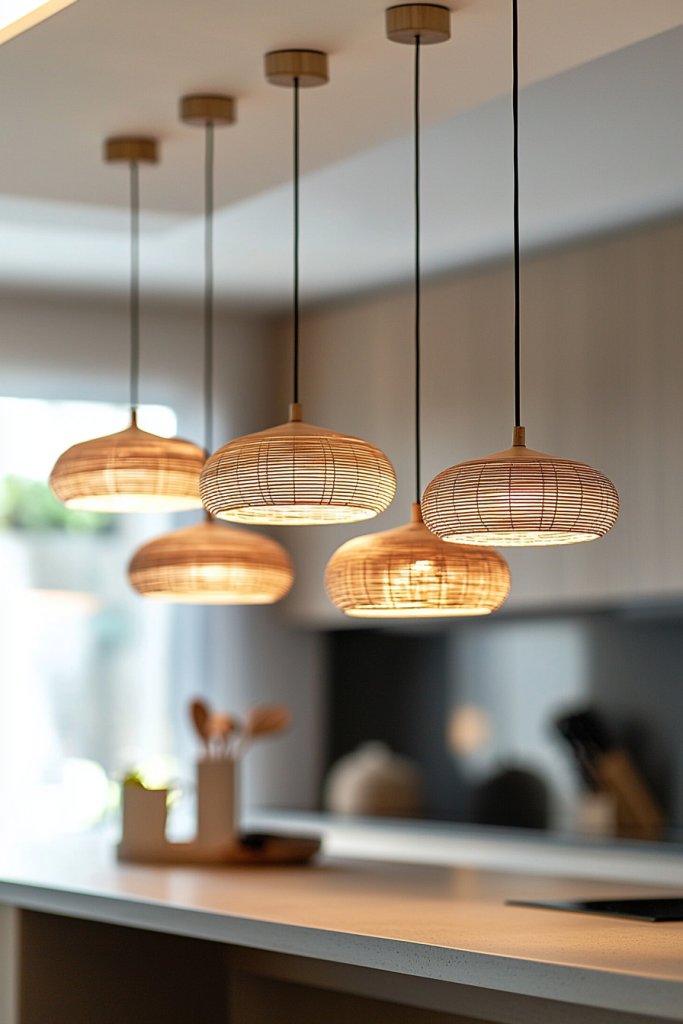
Lighting plays a vital role in establishing the calm and cozy ambiance of a Japandi kitchen. Low-profile pendant lights with natural finishes—such as bamboo, wood, or matte metals—provide gentle, diffused light that complements the minimalist aesthetic.
These fixtures serve as both functional illumination and subtle design statements, enhancing the space’s organic, understated elegance. Imagine a series of small, round pendant lights hanging over a kitchen island, crafted from warm bamboo or light-colored wood, casting a soft, warm glow.
The fixtures are sleek and unadorned, with simple shapes that blend seamlessly into the ceiling. The natural finishes add texture and warmth, creating a cozy atmosphere without overpowering the space.
The light quality is warm and inviting, perfect for both cooking and relaxing, and the fixtures’ minimalist design keeps the visual clutter at bay. To achieve this look, choose pendant lights with simple, compact forms made from natural materials like bamboo, light wood, or matte black or bronze metal with a textured finish.
Install them at a height that provides adequate task lighting while maintaining an airy feel—usually about 24-30 inches above the surface. For an easy DIY option, you can retrofit existing simple pendants with wooden or woven shades. Keep the wiring discreet, and aim for a cohesive, understated look that emphasizes natural materials and soft illumination, creating a tranquil, welcoming environment.
6. Compact, Multi-Functional Kitchen Islands
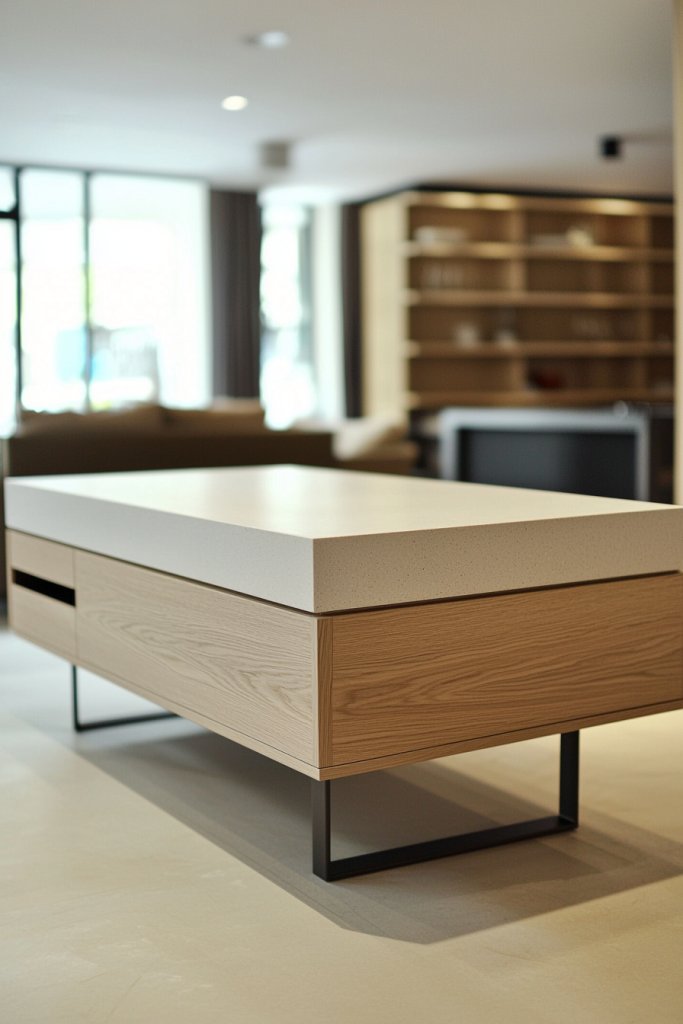
A well-designed kitchen island can be the heart of a Japandi kitchen, combining beauty and utility in a seamless way. It’s not just a surface for prepping food but also a space for casual dining and socializing, all while maintaining a calm, uncluttered vibe.
Recommended Products to replicate this idea
| # | Preview | Product | |
|---|---|---|---|
| 1 |

|
VASAGLE Kitchen Island with 3 Shelves, 47.2 Inches Width Kitchen Shelf with Large Worktop, Stable... | Check Latest Price |
| # | Preview | Product | |
|---|---|---|---|
| 1 |

|
Vtopmart 4 Pack Large Stackable Storage Drawers,Easily Assemble Acrylic Bathroom Closet Undersink... | Check Latest Price |
The key is choosing a piece with clean lines and a minimalist silhouette that complements the overall aesthetic. Picture a sleek, rectangular island crafted from light oak or ash wood, with a smooth, flat top in matte white or stone.
The surface feels cool and sturdy to the touch, and the base features hidden storage drawers to keep clutter out of sight. The overall look is airy and unobtrusive, with subtle details like thin, black metal legs or integrated shelving for a modern yet warm touch.
This space invites you to gather comfortably without overwhelming the room. To create your own multi-functional island, start with a simple, sturdy wooden table or custom-build a piece with a flat, level surface.
Use materials like light oak, birch, or concrete for durability and aesthetic appeal. Incorporate hidden storage solutions such as pull-out drawers or open shelving underneath for pots, utensils, or cookbooks.
Finish with a matte paint or sealant to protect surfaces, and keep accessories minimal to preserve the calming vibe. This approach makes your kitchen both practical and beautifully streamlined.
7. Ceramic or Stone Countertops with Subtle Veining

Countertops in a Japandi kitchen should evoke a sense of calm and natural beauty, making ceramic or stone surfaces with gentle veining an ideal choice. These materials add visual interest without overpowering the minimalist aesthetic, blending durability with understated elegance.
Recommended Products to replicate this idea
| # | Preview | Product | |
|---|---|---|---|
| 1 |

|
Vamos Tile 100-Piece Glossy Dolomite White Peel and Stick Backsplash Tile,3''x6'' PVC Subway Tile... | Check Latest Price |
| # | Preview | Product | |
|---|---|---|---|
| 1 |

|
Weiman Quartz Countertop Cleaner and Polish (2 Pack w/Micro Towel) Clean and Shine Your Quartz... | Check Latest Price |
Their soft patterns evoke natural textures, grounding the space in simplicity and grace. Imagine a countertop of matte-finished ceramic tiles or limestone with faint gray or beige veins that run subtly across the surface.
The textures are smooth yet tactile, inviting you to run your fingers over them as you cook. The neutral tones, like warm taupe or muted gray, complement the surrounding cabinetry and walls, creating a seamless flow that feels both modern and timeless.
The natural veining adds depth and character without disrupting the tranquil atmosphere. To incorporate these countertops, choose ceramic tiles with a matte glaze or engineered stone that mimics natural stone but is more affordable and low-maintenance.
Measure your space carefully and hire a professional for installation to ensure seamless joints. For a DIY approach, opt for self-adhesive ceramic tiles or laminate sheets with a stone pattern, which are easy to install and budget-friendly. Pair with simple backsplash tiles in neutral shades for a cohesive, calm look.
8. Hidden Storage Solutions for a Clutter-Free Space
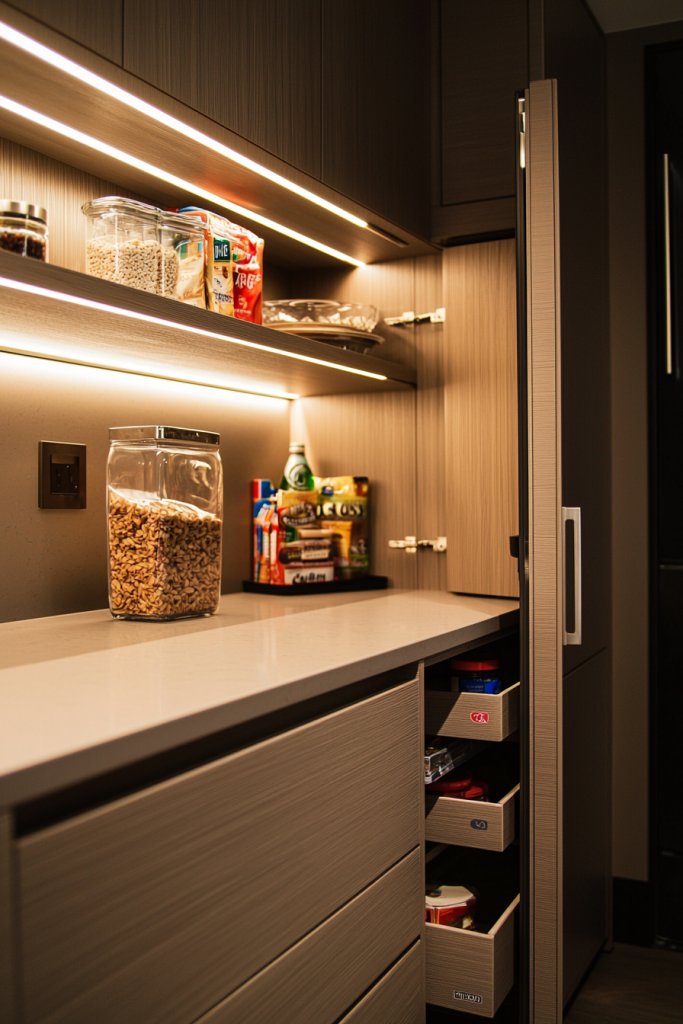
Achieving a serene, uncluttered Japandi kitchen hinges on smart storage that keeps everyday items out of sight. Hidden storage solutions help maintain clean lines and a sense of spaciousness, allowing the natural beauty of materials to shine through.
Recommended Products to replicate this idea
| # | Preview | Product | |
|---|---|---|---|
| 1 |

|
Zonon 8 Pack Magnetic Push Latch Heavy Duty Push to Open Cabinet Hardware Release Touch Latch and... | Check Latest Price |
| # | Preview | Product | |
|---|---|---|---|
| 1 |

|
REALINN Under Sink Organizer, Pull Out Cabinet Organizer 2 Tier Slide Out Sink Shelf Cabinet... | Check Latest Price |
These discreet features are both functional and aesthetic, reducing visual noise and fostering a calm environment. Visualize sleek cabinetry with push-to-open mechanisms, concealed drawers, and built-in organizers that seamlessly blend into the design.
For instance, a cabinet with a flat, handle-less front or a pull-out pantry keeps essentials tucked away yet easily accessible. Under the sink, install pull-out trays or baskets for cleaning supplies, while hidden compartments in the island or countertop can house small appliances.
This approach creates a tidy, harmonious space that feels open and inviting. Start by evaluating your current storage needs and investing in modular cabinetry or custom inserts that maximize space.
Use push-to-open cabinet hardware for a handleless look, and incorporate concealed pull-out shelves or hidden compartments for appliances and utensils. Opt for neutral-colored storage jars and organizers that blend into the cabinetry, and regularly declutter to maintain the peaceful aesthetic. These simple steps turn chaos into calm with minimal effort.
9. Simple, Elegant Tableware in Neutral or Earthy Colors
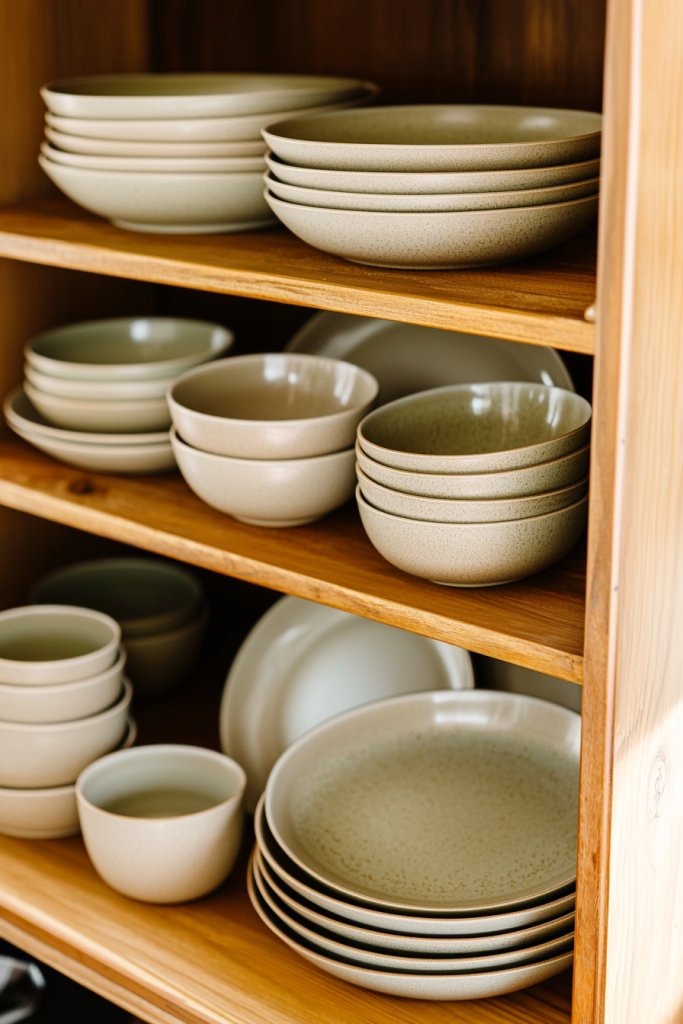
In a Japandi kitchen, the beauty lies in the details—such as choosing tableware that complements the calm, minimalist vibe. Simple, elegant dishes in neutral or earthy tones emphasize understated elegance and create a cohesive look across the space.
Recommended Products to replicate this idea
| # | Preview | Product | |
|---|---|---|---|
| 1 |

|
Amazon Basics 6-Piece White Dinner Plate Set, 10.5 inches | Check Latest Price |
| # | Preview | Product | |
|---|---|---|---|
| 1 |

|
vancasso Starry 24oz Bowls for Soup, Ceramic Deep Soup Bowls Set of 4, Green Cereal Bowls Set for... | Check Latest Price |
These serveware pieces act as both functional items and subtle decorative accents, enhancing the overall atmosphere. Picture a set of ceramic dinner plates with a matte finish in warm beige, soft greys, or muted greens.
Pair them with matching bowls, cups, and serving dishes that feature clean lines and unadorned surfaces. The matte textures and organic shapes evoke a handcrafted feel, adding warmth and tactile interest without clutter.
Arranged neatly on open shelves or a sideboard, this uniformity reinforces a sense of serenity and refined simplicity. To achieve this aesthetic, opt for neutral-colored porcelain or stoneware in classic shapes with minimal embellishments.
Many brands offer affordable, high-quality options that suit a variety of budgets. Consider mixing and matching different textures or subtle variations within the same color palette for visual depth.
Keep your collection small and consistent, and store your tableware in open shelving or built-in cabinets to showcase their understated beauty while keeping your kitchen organized and inviting. If you’d like me to expand on the remaining subheadings, just let me know!
10. Soft Underfoot Rugs in Natural Fibers

Adding soft underfoot rugs crafted from natural fibers is a simple yet powerful way to infuse warmth and coziness into your Japandi kitchen. These plush, textured mats create a welcoming atmosphere that invites you to relax and enjoy the space with every step you take.
Recommended Products to replicate this idea
| # | Preview | Product | |
|---|---|---|---|
| 1 |

|
S & L Homes Jute Cotton Hand Woven Natural Farmhouse Area Rug for Living Room - Rustic Vintage... | Check Latest Price |
| # | Preview | Product | |
|---|---|---|---|
| 1 |

|
SAFAVIEH Area Rug 8x10 - Natural Fiber Collection - Large - Marble & Beige, Sisal, Woven Design... | Check Latest Price |
Imagine walking across a beautiful jute or sisal rug, its earthy tones ranging from sandy beige to warm caramel, complementing the neutral color palette of the kitchen. The fibers have a slightly rough texture that contrasts softly with smooth stone countertops and matte ceramic tiles, adding a tactile dimension to the room.
Underneath, the gentle crunch of fibers underfoot and the subtle earthy scent of natural materials enhance the sensory experience, making the space feel grounded and serene. Layered with woven baskets and minimalist cushions, these rugs contribute to the overall calming and understated aesthetic characteristic of Japandi design.
To recreate this cozy touch, start by choosing a natural fiber rug such as jute, sisal, or wool in neutral shades like cream, taupe, or light grey. Lay it down in high-traffic areas like in front of the sink or under the kitchen table for maximum impact.
For an easy DIY option, you can buy ready-made rugs from home decor stores or online, and if needed, trim larger rugs to fit your space precisely. To maintain their beauty, vacuum gently and rotate periodically to prevent uneven wear. Incorporating these tactile, earthy rugs will instantly elevate your kitchen’s comfort level while seamlessly blending into the Japandi style.
11. Discreet, Integrated Appliances for Seamless Design
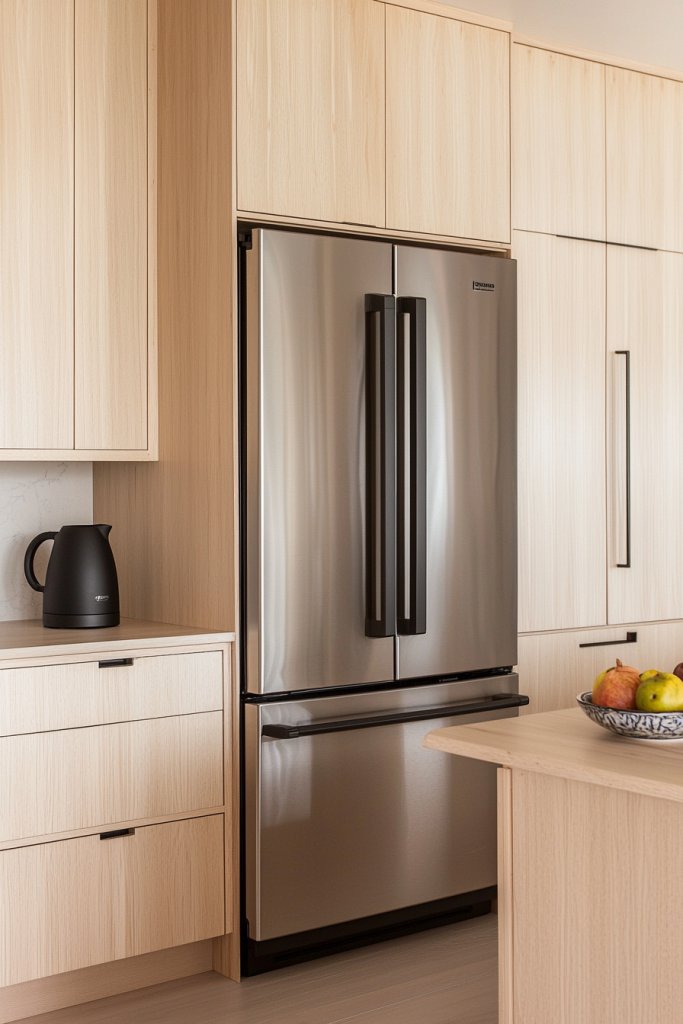
In Japandi kitchens, the goal is to achieve a sleek, clutter-free environment that radiates calm and simplicity. Hidden or integrated appliances play a crucial role in maintaining this minimalist aesthetic, allowing the focus to remain on natural materials and clean lines rather than on bulky tech.
Recommended Products to replicate this idea
| # | Preview | Product | |
|---|---|---|---|
| 1 |

|
Weili 20 Inch Built in Beverage Refrigerator with Lock, Under Counter or Freestanding 120 Can... | Check Latest Price |
Imagine a kitchen where the refrigerator and dishwasher are seamlessly embedded within light wood cabinetry, with flush-mounted doors that blend effortlessly. The countertops are clear, with just a few carefully chosen accessories like a matte black kettle or a ceramic fruit bowl.
The appliances, often in neutral tones like matte black, brushed stainless, or matching cabinetry panels, disappear into the background, creating a unified, calming visual flow. Soft, natural lighting enhances the smooth surfaces, emphasizing the understated elegance and spaciousness of the space.
To recreate this look, start by selecting built-in appliances that match your cabinet color or are designed to blend in. Measure your space carefully, then choose models with minimal handles or touch-to-open mechanisms for a sleek finish.
Install the appliances flush with the cabinetry for a seamless appearance. If full integration isn’t feasible, consider using appliance covers or panels that mimic the cabinetry’s wood or matte finish. Basic tools, a level, and patience are all you’ll need to achieve this refined, clutter-free aesthetic.
12. Subtle Decorative Accents in Ceramics and Sculptures
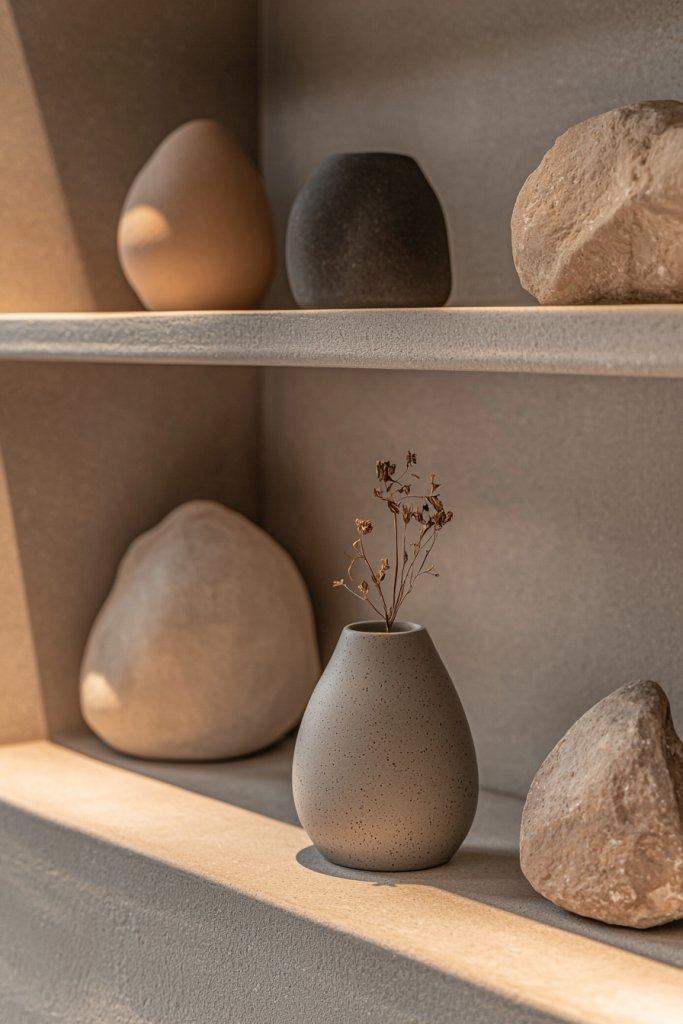
Adding personality to a Japandi kitchen doesn’t mean cluttering the space—it’s about choosing carefully curated accents that bring warmth and charm without overwhelming the calm atmosphere. Handcrafted ceramics and minimalist sculptures serve as understated focal points, subtly elevating the room’s aesthetic.
Recommended Products to replicate this idea
| # | Preview | Product | |
|---|---|---|---|
| 1 |

|
Vanselia Ceramic Flower Vase Home Decor - Large Farmhouse Table Vases Rustic Vintage Living Room... | Check Latest Price |
| # | Preview | Product | |
|---|---|---|---|
| 1 |

|
Ozzptuu Sandstone Resin Thinker Style Abstract Sculpture Statue Collectible Figurines Home Office... | Check Latest Price |
Visualize a small, matte ceramic vase with a simple, organic shape sitting on a shelf or countertop, holding a single dried flower or a sprig of herbs. Smooth, rounded sculptures in stone or clay, perhaps abstract or inspired by nature, can be displayed on open shelves or within recessed niches.
These accents come in earthy tones—soft taupe, warm terracotta, matte black—complementing the overall neutral palette. The textures are tactile, inviting gentle touches that add to the cozy, inviting feel.
Their placement is strategic, often at eye level or on a prominent surface, where they can be appreciated without cluttering the space. To incorporate these accents, browse local ceramic artisans or online shops for handcrafted pieces.
Opt for simple shapes with matte finishes—no glossy or overly ornate designs—and keep the number of decorative objects minimal to maintain the clean, Zen-inspired vibe. Position sculptures or ceramics on open shelving, atop kitchen islands, or on windowsills, ensuring they enhance rather than dominate the space. These subtle touches create a sense of curated calm, reinforcing the Japandi aesthetic.
13. Warm Lighting with Dimmer Switches for Mood Adjustment
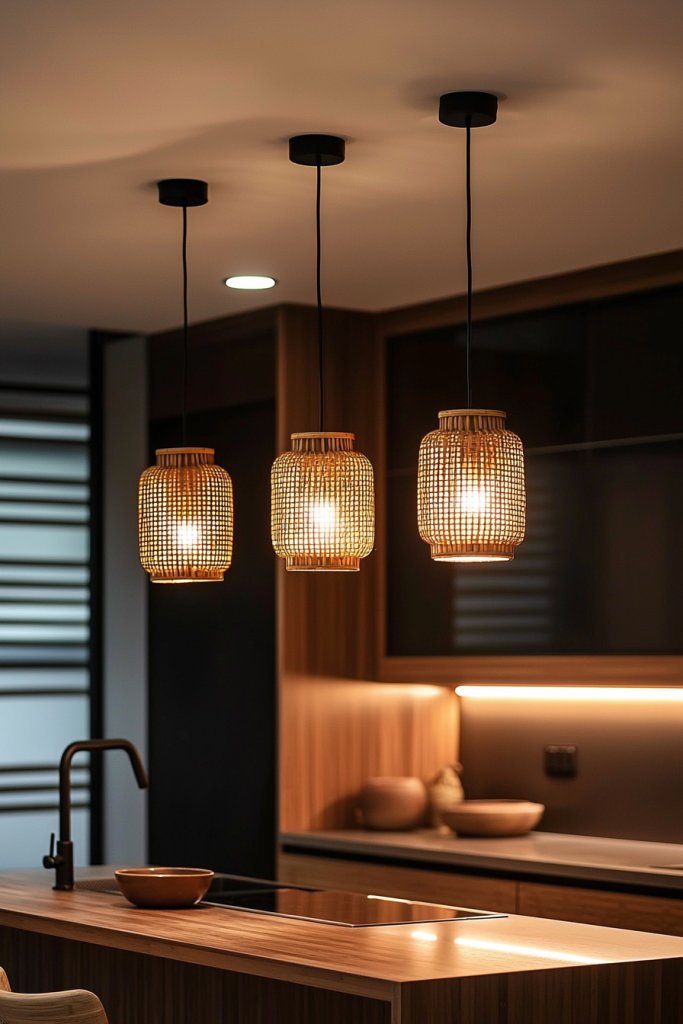
Lighting in a Japandi kitchen is all about creating a warm, inviting atmosphere that can be easily adjusted for different moments—whether cooking, dining, or relaxing. Soft, layered lighting with dimmer switches adds flexibility, allowing you to tailor the ambiance to suit your mood.
Recommended Products to replicate this idea
| # | Preview | Product | |
|---|---|---|---|
| 1 |

|
Linkind A19 LED Light Bulbs Dimmable, 60W Equivalent, 2700K Soft White, 9.5W 800 Lumens, E26... | Check Latest Price |
| # | Preview | Product | |
|---|---|---|---|
| 1 |

|
CAFULAM Modern Black Farmhouse Pendant Light with Glass Shade,Industrial Pendant Lighting,... | Check Latest Price |
Picture a kitchen illuminated by a combination of warm LED bulbs in modern, minimalist fixtures. Pendant lights made of bamboo or matte metal hang delicately above the island, casting gentle pools of light.
Recessed ceiling lights provide ambient glow, while under-cabinet strips softly highlight work surfaces. Installing dimmer switches on all light sources allows you to effortlessly lower the brightness for cozy evenings or brighten for detailed tasks.
This layered approach emphasizes the textures of natural wood, ceramics, and textiles, making the space feel even more warm and welcoming. To implement this, choose warm-toned bulbs (around 2700K) and fixtures with simple, understated designs.
When installing, consult an electrician to add dimmer switches to your main lighting circuits. Use smart bulbs or dimmer modules compatible with your existing setup for easier control. This adaptable lighting plan enhances the serenity of your kitchen, making it a perfect space for both lively gatherings and quiet moments of reflection.
14. Functional yet Decorative Storage Jars and Canisters
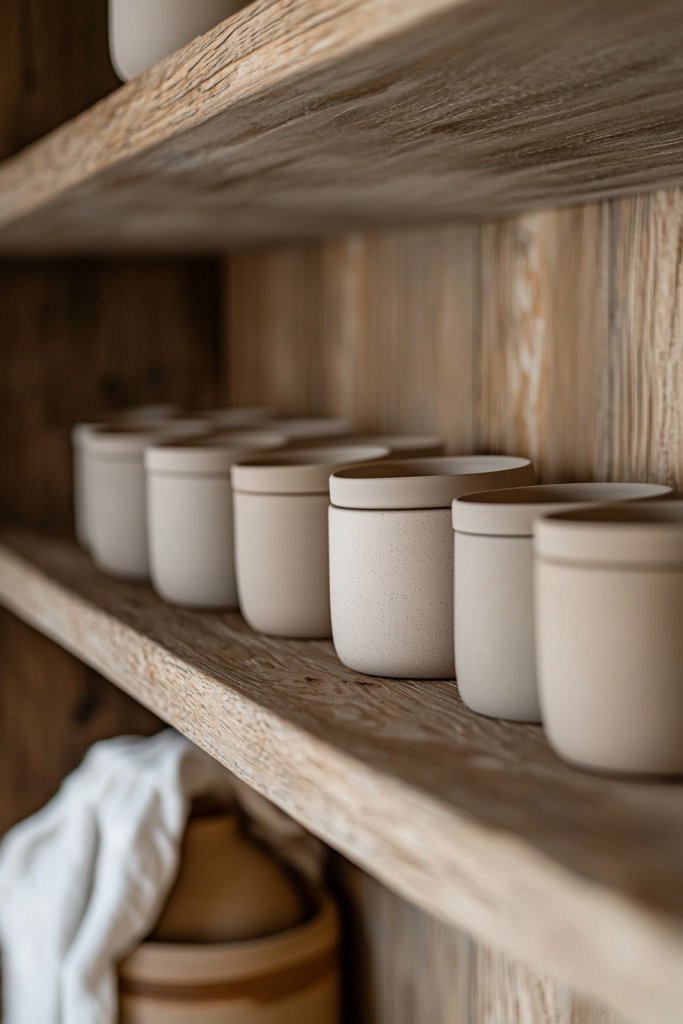
In Japandi kitchens, storage solutions are designed to be both practical and beautiful, blending seamlessly into the overall aesthetic. Simple, matte-finished jars and canisters keep essentials close at hand while adding subtle decorative charm to open shelves or countertops.
Recommended Products to replicate this idea
| # | Preview | Product | |
|---|---|---|---|
| 1 |

|
Creative Co-Op Unique Marble and Mango Wood Pinch Pot Canister with Lid, Vary Slightly in Color... | Check Latest Price |
| # | Preview | Product | |
|---|---|---|---|
| 1 |

|
Anchor Hocking Heritage Hill 1 Gallon Glass Jar with Lid, Set of 2 | Check Latest Price |
Visualize a row of uniform, neutral-colored ceramic jars with minimalist labels or no labels at all, neatly lined up on a wooden shelf. Their organic shapes and muted tones—warm taupe, soft gray, or earthy terracotta—complement the natural textures of wood and linen in the space.
These containers hold staples like rice, pasta, or tea leaves, serving both as functional storage and design accents. Their matte finishes prevent glare, while their uniformity creates visual harmony, making the kitchen feel orderly and cozy.
To achieve this look, select canisters made of ceramic, glass, or matte-finished metal in neutral hues. For a budget-friendly option, repurpose glass jars with simple labels or chalkboard paint.
Keep the arrangement tidy and consistent, placing the jars within easy reach but in a way that keeps the countertop uncluttered. Incorporate these storage jars into your kitchen design to add a layer of understated elegance that enhances the calm, organized vibe of Japandi style.
15. Textured Backsplash in Neutral Tones
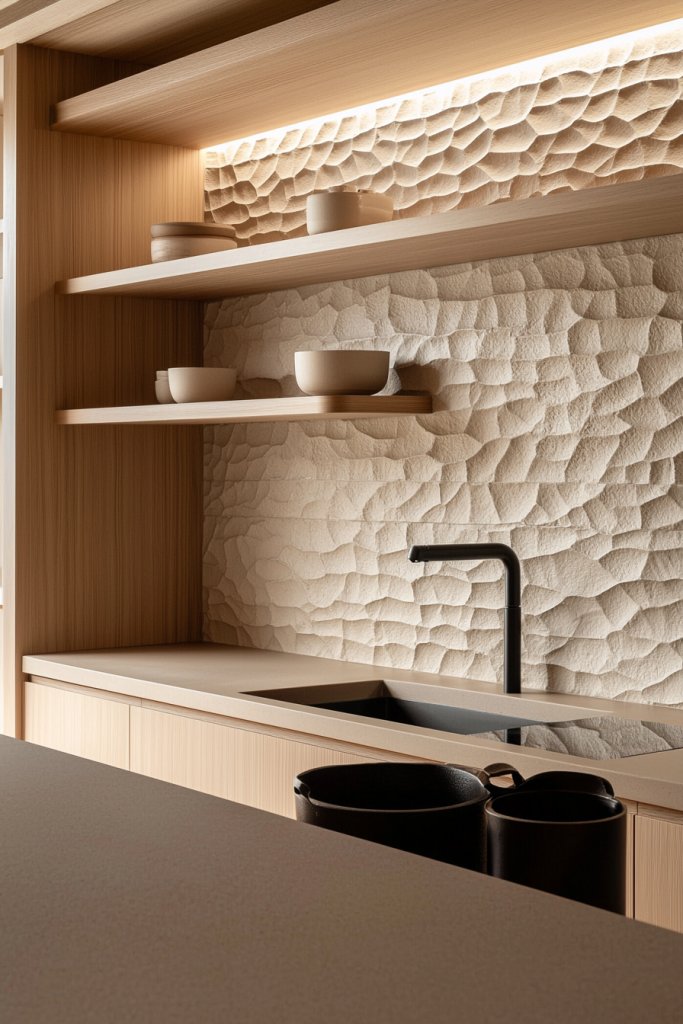
The backsplash in a Japandi kitchen acts as a subtle yet impactful design element, adding depth and visual interest without disrupting the minimalist harmony. Textured tiles or panels in neutral tones evoke natural materials like stone or clay, offering a tactile dimension that complements the overall calm aesthetic.
Imagine a backsplash composed of matte, textured ceramic tiles with a gentle rippled or matte stone finish, in shades of warm beige or soft gray. The surface has a tactile quality that invites touch and provides a gentle play of light and shadow, enhancing the space’s depth.
The subtle texture contrasts beautifully with smooth countertops and flat cabinetry while maintaining the understated elegance central to Japandi design. The overall effect is a calming, cohesive environment that feels both natural and sophisticated.
To incorporate this feature, choose textured tiles from your local tile supplier or online retailers—look for matte finishes with minimal gloss. Install them with a thin, neutral grout line to emphasize the texture rather than distract from it.
For easy maintenance, opt for high-quality, durable materials suited for kitchen environments. This textured backsplash adds a quiet layer of visual sophistication, enriching the overall sense of tranquility and natural beauty in your Japandi kitchen.
16. Clear, Uncluttered Countertops with Thoughtful Placement
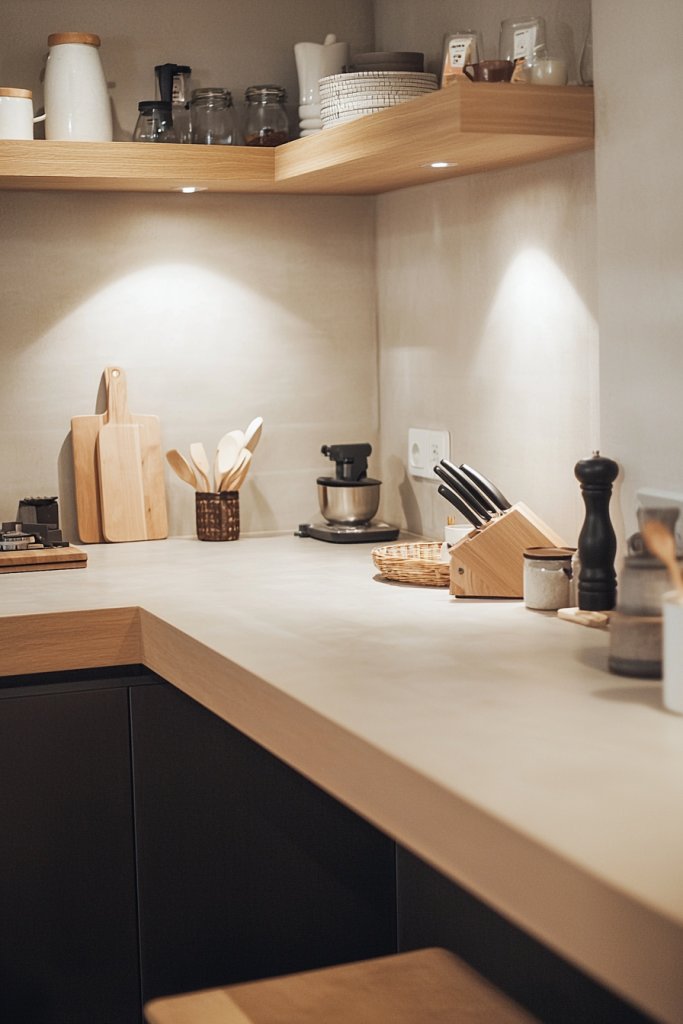
A tidy countertop instantly transforms your kitchen into a peaceful, inviting space—perfect for embracing the calm and simplicity of Japandi style. Keeping surfaces free of clutter not only enhances visual serenity but also makes daily routines smoother and more enjoyable.
Recommended Products to replicate this idea
| # | Preview | Product | |
|---|---|---|---|
| 1 |

|
Cisily Black Sponge Holder for Kitchen Sink, Sink Caddy Organizer with High Brush Holder, Kitchen... | Check Latest Price |
| # | Preview | Product | |
|---|---|---|---|
| 1 |

|
White Pedestal Decorative Bowl - 8" Minimalist Decorative Fruit Bowl for Kitchen Counter,... | Check Latest Price |
Imagine a pristine marble or matte stone surface, with only a few carefully selected essentials like a minimalist ceramic fruit bowl, a sleek wooden cutting board, and a simple glass jar for utensils. The space feels open and airy, with soft natural light highlighting the subtle textures of the materials.
The overall effect is a balanced, harmonious environment where every item has a purpose and a place, fostering a sense of calm and order. The gentle scent of wood and clean linens adds to the soothing atmosphere, making the kitchen a true sanctuary.
To achieve this, start by removing unnecessary items from your countertops. Use shallow trays or small baskets to organize daily essentials, and store less-used items in cabinets or drawers.
Select a few high-quality, visually appealing pieces—like a matte black kettle or a neutral-toned utensil holder—and keep them within easy reach. Regularly declutter to maintain the clean look, and choose hidden or built-in storage options wherever possible to preserve the minimalist aesthetic. This simple change can make your kitchen feel more spacious and inviting in no time.
17. Cozy Nook with a Built-in Bench and Cushions
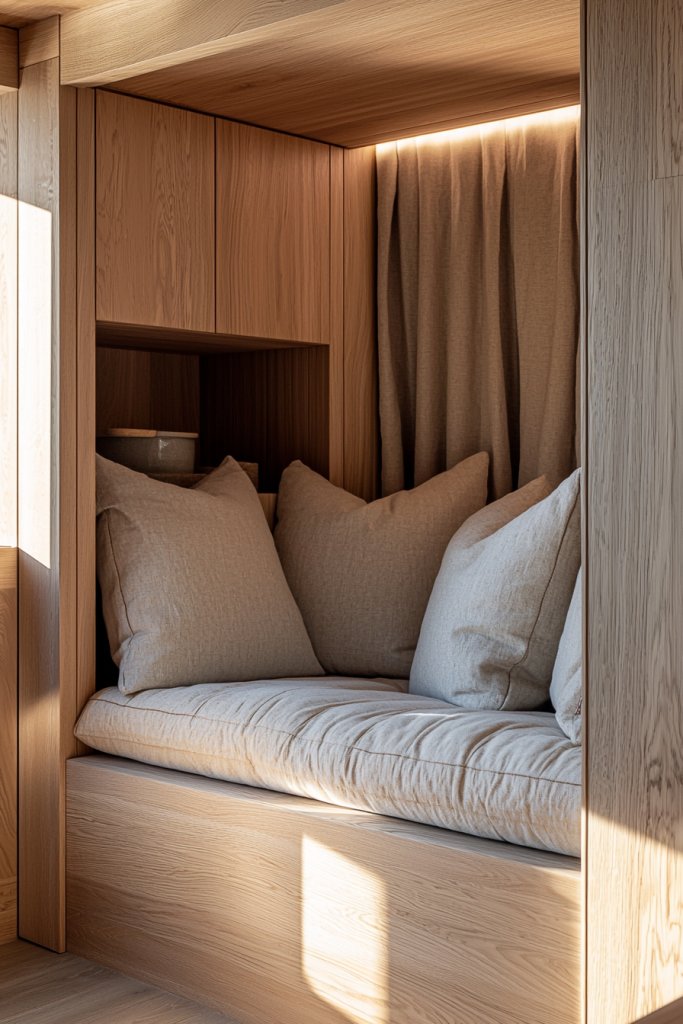
Creating a cozy corner with a built-in bench and cushions offers a warm, inviting space for relaxed meals or quiet moments, perfectly aligned with Japandi’s emphasis on comfort and functionality. This small retreat adds both visual charm and practical use to your kitchen.
Visualize a slim, elegant wooden bench integrated into a corner or along a wall, topped with plush cushions in muted tones like beige, soft grey, or warm taupe. Layering textures—such as a chunky knit throw blanket or woven pillow covers—adds tactile softness, while a simple wood-framed window seat provides a sense of enclosure and intimacy.
The overall look is understated yet inviting, with natural wood tones and neutral textiles blending seamlessly into the calm atmosphere. Ambient light filters softly through a nearby window, enhancing the tranquil vibe.
To build this nook, start by measuring the available space and choosing a durable, light-colored wood for the bench frame—such as oak or birch. Secure the structure to the wall or floor for stability.
Add cushions made from soft linen or cotton, available in neutral shades, and incorporate textured throws for extra coziness. Finish with a small side table or a woven basket nearby for added functionality. This simple DIY project can be customized to fit your space and style, transforming an overlooked corner into your favorite spot for unwinding.
18. Use of Matte Finishes on Hardware and Fixtures
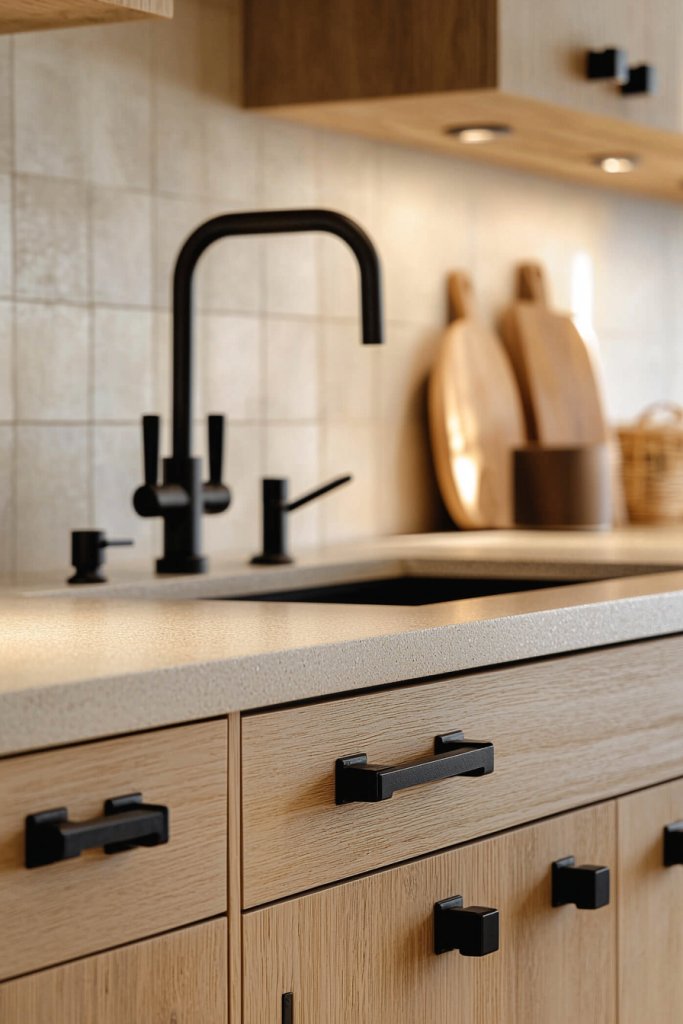
Matte finishes on kitchen hardware and fixtures lend a subtle, sophisticated elegance that complements the muted, natural palette of Japandi design. This understated look minimizes glare and adds a modern touch, perfectly balancing simplicity with style.
Recommended Products to replicate this idea
| # | Preview | Product | |
|---|---|---|---|
| 1 |

|
10 Pack 2 inch Cabinet Pulls Matte Black Stainless Steel Kitchen Drawer Pulls Cupboard Handles... | Check Latest Price |
| # | Preview | Product | |
|---|---|---|---|
| 1 |

|
DJS Kitchen Faucets with Pull Down Sprayer Matte Black - Dual Mode Setting Single Handle 1 or 3... | Check Latest Price |
Picture sleek matte black cabinet handles, brushed nickel faucet, or bronze drawer pulls—all with smooth, non-reflective surfaces that absorb light rather than bounce it. These fixtures blend seamlessly into the cabinetry, creating a cohesive, harmonious appearance that feels calm and grounded.
The matte texture adds a tactile dimension, inviting touch and enhancing the overall sensory experience of the space. The muted finish also helps to hide fingerprints and smudges, maintaining a clean, polished look over time.
To incorporate matte finishes, choose hardware and fixtures made from durable materials like powder-coated metal, brushed stainless steel, or ceramic. Opt for simple, minimalist designs that align with the overall aesthetic—think straight lines and subtle curves.
Installing these fixtures is straightforward: remove existing hardware and carefully attach the new matte pieces, following manufacturer instructions. For a budget-friendly update, many home improvement stores offer a wide range of matte-finished options, making it easy to elevate your kitchen’s mood with just a few thoughtful swaps.
19. Layered Textures Through Soft Fabrics and Wooden Elements
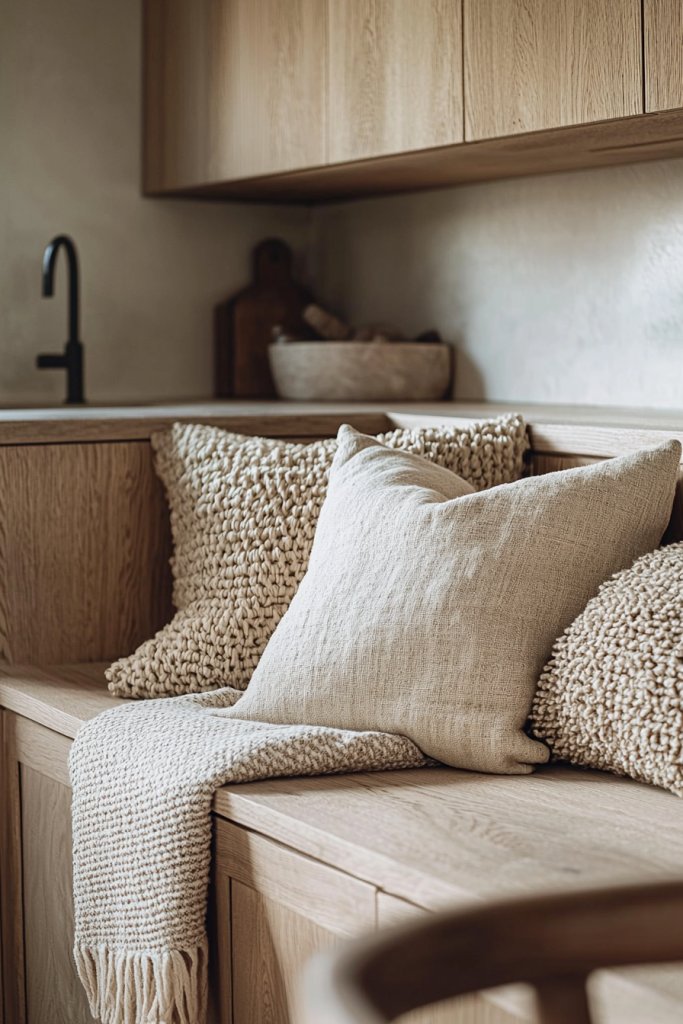
Layering textures is a hallmark of Japandi design, creating a warm, inviting environment that’s rich in tactile interest. Combining soft fabrics with natural wooden elements results in a cozy, balanced kitchen that feels both stylish and functional.
Recommended Products to replicate this idea
| # | Preview | Product | |
|---|---|---|---|
| 1 |

|
LANE LINEN Kitchen Towel Set- 12 Pack 14"x25" Dishtowels for Kitchen, Absorbent 100% Cotton Dish... | Check Latest Price |
| # | Preview | Product | |
|---|---|---|---|
| 1 |

|
DUMOS 5 Tiers Bookshelf, Classical Modern Book Shelf, Tall Display Shelves in Living... | Check Latest Price |
Visualize a kitchen with smooth wooden cabinets and open shelving, accented by woven baskets, soft linen dish towels, and chunky knit textiles. Underfoot, a textured jute or sisal rug adds warmth and durability, grounding the space with earthy tones.
The tactile contrast between the sleek wood surfaces and plush, woven fabrics invites touch and enhances the sensory experience. Soft lighting casts warm glows over these textures, emphasizing the layered depth and creating a cozy, serene atmosphere.
To achieve this layered look, start by selecting natural materials like linen, wool, or cotton for soft furnishings—such as cushions, dish towels, and placemats. Incorporate wooden accents, like a reclaimed wood cutting board or a pair of open shelves, to add visual warmth.
Mix and match textures intentionally, ensuring that each element complements the others without cluttering the space. These small touches can dramatically elevate your kitchen’s ambiance, making it a sanctuary of comfort and understated elegance.
20. Incorporating Traditional Japandi Elements in Modern Settings
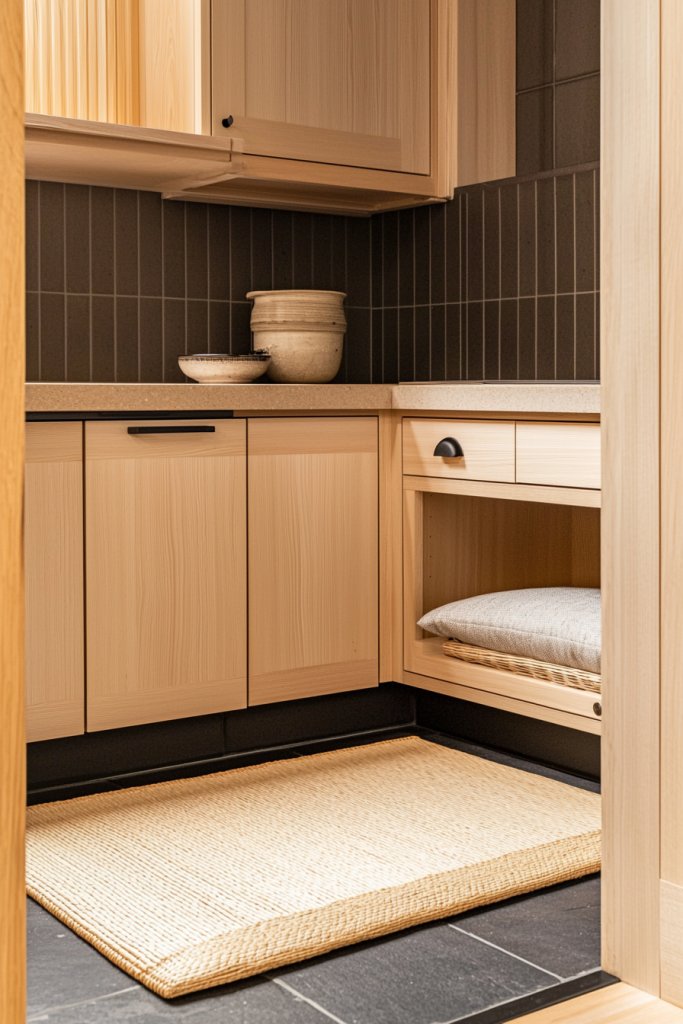
Blending traditional Japanese craftsmanship with Scandinavian minimalism is at the heart of Japandi interior design, creating a balanced aesthetic rooted in function, simplicity, and natural beauty. This approach infuses modern kitchens with timeless elegance and cultural depth.
Recommended Products to replicate this idea
| # | Preview | Product | |
|---|---|---|---|
| 1 |

|
Linon Natural Barstool with Round Seat, 24-Inch | Check Latest Price |
| # | Preview | Product | |
|---|---|---|---|
| 1 |

|
Vanselia Ceramic Flower Vase Home Decor - Large Farmhouse Table Vases Rustic Vintage Living Room... | Check Latest Price |
Imagine sleek, minimalist cabinetry paired with handcrafted Japanese woodwork details—such as intricate joinery or subtle carvings—complemented by Scandinavian-inspired furniture with clean lines. Use natural materials like bamboo, stone, and light-colored woods, combined with neutral tones and understated decorative accents like ceramic bowls or woven baskets.
The overall space feels harmonious, with a sense of intentionality and mindfulness behind every element, reflecting a deep respect for craftsmanship and simplicity. The design encourages slow living and appreciation of natural textures, making your kitchen not just functional but also inspiring.
To incorporate these elements, start with a neutral color palette of beiges, greys, and warm woods. Select furniture or accessories with craftsmanship details inspired by Japanese or Scandinavian traditions, such as a handcrafted wooden stool or a textured ceramic vase.
Use natural, sustainable materials wherever possible, and focus on clean, uncluttered surfaces that emphasize quality over quantity. Combining these traditional influences with modern practicality results in a kitchen that feels both timeless and current—a space that invites you to slow down and enjoy everyday moments with style.
21. Thoughtful Layout for Ease and Flow
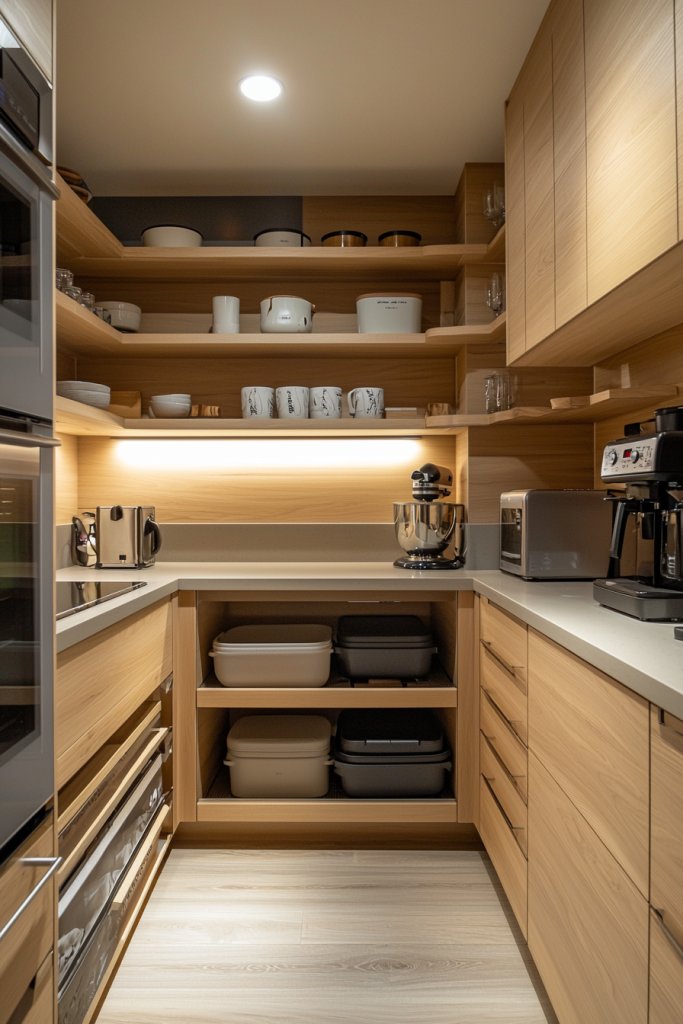
Creating a thoughtfully arranged kitchen layout is fundamental to achieving the calm and cozy atmosphere characteristic of Japandi design. When everything flows naturally, the space feels more inviting and functional, reducing stress during daily routines.
Recommended Products to replicate this idea
| # | Preview | Product | |
|---|---|---|---|
| 1 |

|
Bookcases, Cabinets & Built-Ins | Check Latest Price |
| # | Preview | Product | |
|---|---|---|---|
| 1 |

|
IRONCK Rolling Kitchen Island Table on Wheels with Drop Leaf, Storage Cabinet, Drawer,... | Check Latest Price |
A well-planned layout emphasizes balance, harmony, and accessibility, making the kitchen both beautiful and practical. Imagine walking into a kitchen where the arrangement feels intuitive—counters are uncluttered, appliances are seamlessly integrated, and pathways between zones are clear.
The space uses a balanced distribution of functional zones: a prep area with a smooth wooden countertop, a storage zone with hidden cabinets, and a cozy nook for casual dining. Gentle proportions and symmetry guide the eye, while a neutral color palette with warm accents ties everything together.
The overall effect is a space that promotes ease of movement and calmness, embodying the serene Japandi aesthetic. To implement this, start by sketching a basic floor plan, focusing on natural traffic flow.
Place major appliances in built-in, concealed units to maintain clean lines. Position the kitchen island centrally to serve multiple functions—prep, storage, and casual seating—without obstructing pathways.
Use minimal, unobtrusive furniture and avoid overcrowding surfaces. Consider the height and scale of each element to ensure comfort and harmony. Simple tools like masking tape and paper templates can help visualize the layout before making permanent changes, making the process accessible and stress-free.
Conclusion
These 21 Japandi kitchen ideas offer a perfect blend of simplicity, warmth, and functionality to create a calm and cozy space. From minimalist open shelving and neutral palettes to textured textiles and integrated appliances, each element contributes to a harmonious design.
Embrace these concepts to transform your kitchen into a serene retreat that reflects your personal style. Start incorporating these ideas today and enjoy the timeless beauty of Japandi living.
Last update on 2025-09-21 / Affiliate links / Images from Amazon Product Advertising API
Leave a Reply